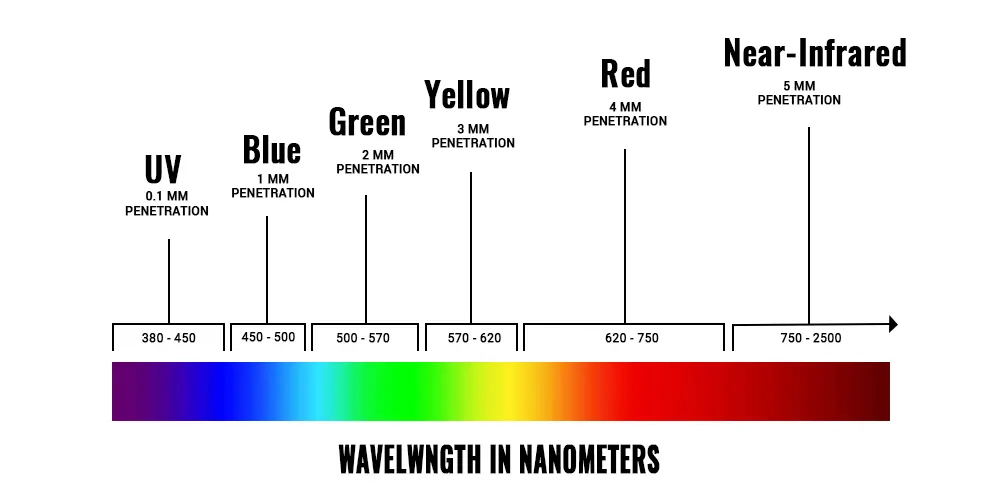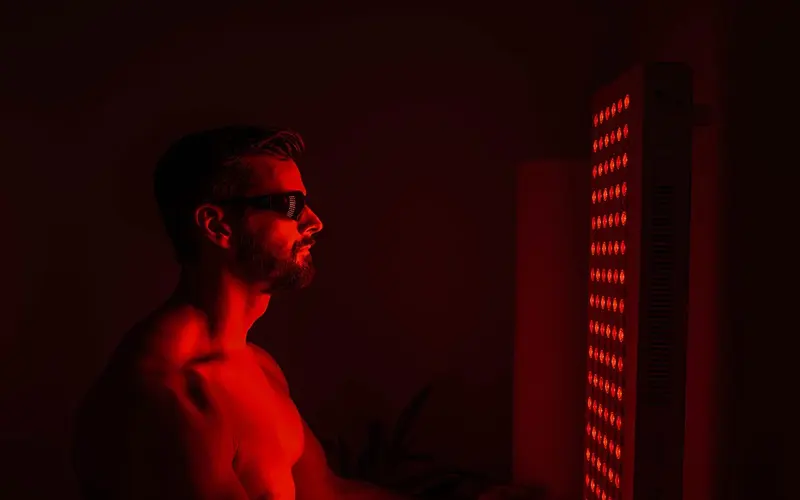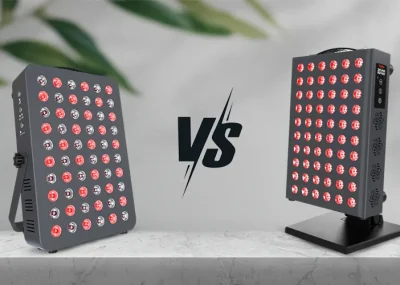Red Light Therapy (RLT) relies on use of light energy as an alternative form of treatment that can be used with other traditional treatment options. The light used is not just any run-of-the-mill type of light but rather light that is referred to as wavelengths.
These wavelengths vary in intensity, and their application is dependent on the area of treatment or concern. With a range of between 620 nm to 750 nm, these wavelengths work by triggering an increase in energy within the cells leading to tissue recovery, rejuvenation, and improved cell function.
Dr. Ayah, a clinical aesthetician states,
Red light therapy wavelength plays a major role in helping with collagen creation and reduction of inflammation.
Even though quite popular right now, RLT’s inventor Niels Ryberg Finsen was reluctant when it came to using the technology as he didn’t understand how it worked. In 1903 the Danish physician discovered that exposure of red light therapy to sores hastened their healing process. For this, he was recognized and went ahead to win a Nobel prize.
To help you understand its popularity despite some reluctance from its inventor, we shall take a deep dive into the world of red light therapy. In this article, we shall look at its benefits, how it works, if it has any side effects, and much more.
Red Light Therapy: What is It?
A century ago red light therapy was discovered and put into practice. Decades later, a voyage to outer space brought to light its potential benefits and effectiveness in treating various health issues leading to its popularity and acceptance.
According to Janis T. Ells, a professor and RLT researcher,
Red light was being used in research and experiments to determine its impact on the growth of plants. Healing was unheard of in space, but the astronauts taking care of the plants noticed scratches they had on their hands healing.
This discovery has paved the way for advancements in horticulture, including the use of Best Grow Lights for Plants. Modern LED grow lights mimic the beneficial red wavelengths, ensuring robust plant growth and vitality.
And from this discovery, years of research through funding provided by NASA led to the conclusion that light therapy could be used as an alternative treatment option for healing.
It is also known as photobiomodulation, but you can also refer to it as PBM or LLLT (Low-Level Light Therapy). Other names that you might come across are biostimulation (BIOS) or light box therapy.
The “low-level” term in one of the names above comes from the concept of the low wavelengths of light that you expose to the treatment area. The energy density of these lights is much lower than other types of laser treatments.
Once it penetrates your body at a depth of 10 millimeters it triggers energy production at a cellular level resulting in accelerated metabolic processes that contribute to faster healing of affected areas.
Understanding How Red Light Therapy Works
To expose your body or treatment area to red light therapy, you use a light-emitting device specific to your needs. Through this, your cells can work faster, helping reduce inflammation, joint pain, and other related issues, hasten the healing process of wounds or nerves while also helping with other health orders and, in some cases, weight loss.
As the energy levels in the cells increase through RLT sessions, the cells can move and migrate to the areas that require attention therefore starting the healing and rejuvenation process.
Dr. Casey Kelley states,
Red light therapy targets the powerhouse of your cells boosting, the energy to levels that promote quicker healing and growth.
Even though a form of laser treatment, red light therapy does not produce results through trauma or damaging your skin barrier as is the case with some therapies. With LLLT you can experience positive results through a non-invasive process that only requires cells to be exposed to low-level light and get activated ; this process is known as photobiomodulation.
 Red Light Therapy Wavelengths
Red Light Therapy WavelengthsBenefits and Uses of Red Light Therapy Wavelengths
Research carried out by experts and scientific results that can be found are indicators of some potential health benefits that come from using red light therapy. Below, we shall take a look at some of the possible benefits.
Helps with Skin and Hair Concerns
Addressing skin conditions has got to be one of the most popular uses of red light therapy. For this particular use, you can have the sessions in the comfort of your home with the help of innovative red light devices. Below we highlight some of the conditions that you can treat through such sessions
- Lines and wrinkles – some studies and research have shown how red light therapy can help reduce signs of aging by boosting collagen production. Thereby improving your skin’s elasticity and smoothening out the lines/ wrinkles on your face and neck
- Acne – as a complementary treatment method, red light therapy can be used with other treatment options that help boost its ability to produce positive results. It works well for mild and moderate acne by reducing inflammation and destroying acne-causing bacteria
- Reduce redness and inflammation – red light therapy helps you deal with several skin conditions with a single treatment session, so while you might be targeting a condition like acne, the sessions will also help reduce inflammation, which in turn controls redness
- Healing of wounds – wounds that may be present on the skin due to conditions like diabetes can heal through the use of red light therapy. The accelerated healing process is attributed to the increased cell function, which contributes to collagen production, tissue regeneration, and decreased pain and inflammation
- Promote hair growth – for individuals experiencing alopecia (hair loss), red light therapy has been known to reduce its impact by reducing inflammation and promoting enough blood flow to the scalp. With an adequate supply of oxygen and nutrients to your follicles, you will be able to tackle hair loss and have thick, healthy strands
Reduce Pain
After skincare, this has got to be one of the other uses of red light therapy. If used correctly and within the provided guidelines RLT can control pain and inflammation. Individuals with chronic pain like fibromyalgia have benefited from the use of FDA-approved FibroLux laser treatment.
Helps With Brain Health
Even though studies are still ongoing and more research needs to be done, there have been promising results with the use of red light therapy to improve cognitive function by promoting adequate blood flow and oxygen to the brain.
Studies being carried out indicate and point towards benefits from the application of brain photobiomodulation in promoting neuron formation. Individuals set to benefit from this application are those with brain injuries, memory loss, or those who have had strokes.
Improves Athletic Ability and Injury Recovery
Before a workout or a sports activity, you can use red light therapy to activate your mitochondria thus improving your performance and recovery after exercises. The accelerated energy production in the cells also promotes muscle growth and repair.
Helps with the Management of Cancer Side Effects
It is well known that cancer treatment comes with some side effects like oral mucositis which is often painful. This condition causes sores, swelling, bleeding, and irritation can be treated and prevented with PBM.
Eye Health
Red Light Therapy for Eyes offers significant benefits, including the potential to improve vision and reduce the risk of age-related eye conditions. Specific wavelengths in red light therapy can enhance mitochondrial function in retinal cells, promoting eye health and overall visual acuity.
What are The Side Effects of Using Red Light Therapy Wavelengths?
There are no known major side effects associated with red light therapy. Some common mild side effects you might experience are your skin becoming itchy, some redness in the areas of treatment, or some hyperpigmentation.
These side effects usually disappear on their own after a while or as your body re-adjusts and gets used to the treatments; you can alleviate them further by using the red light devices properly at the recommended wavelength for each condition.
Individuals with conditions similar to photosensitivity or under medications that trigger such conditions are advised against using red light therapy. The same restriction applies to expectant women also.
Frequently Asked Questions
Q: Which is the best red light therapy wavelength?
A: The best wavelength strength known to produce positive results is 630 nanometers to 700 nm. The one that is common and mostly recommended is 660 nm.
Q: What are the most common red light therapy benefits?
A: The most common benefits of using red light therapy are skin repair and rejuvenation, cell regeneration, and pain alleviation and management.
Q: Who cannot use red light therapy?
A: Red light therapy is not recommended for expectant women, people with a photosensitivity condition, or if you suffer from seizures and have eye conditions that can become worse by changing lights.
Conclusion
Often categorized as a form of laser treatment or photomedicine, Red Light Therapy stands out as an alternative non-invasive treatment option for various issues within the body. Despite there being little research concerning light box treatment, the benefits and success stories highly point to it being a great treatment option for skin and other health issues.
Additionally, it is considered safe as no side effects have been reported thus far related to use of RLT. If you are a beginner to this type of treatment don’t go by your friends or relatives treatment plan. What works for others and the results they experience will vary and might not be the same for you. It is advisable to consult a certified dermatologist to get the correct input before you get started.
For best results since it is also considered a complementary form of treatment, you can use it with other types of treatment like topical creams to cater to skin issues or physical therapy to help with physical injuries or joint pain.
Furthermore, recent advancements in red light therapy have introduced the 810 Nanometer Wavelength, offering additional options for addressing various health concerns. This wavelength, known for its deep tissue penetration capabilities, has shown promise in enhancing the effectiveness of red light therapy treatments for conditions such as muscle soreness, inflammation, and pain relief.
In addition to red light therapy devices, the RedMed Light Therapy App is an innovative application that claims to emit red light at a wavelength of 620nm. This specific wavelength is known for its numerous benefits, such as boosting cellular energy, rejuvenating skin, reducing wrinkles and fine lines, decreasing inflammation, and promoting healing over time.







